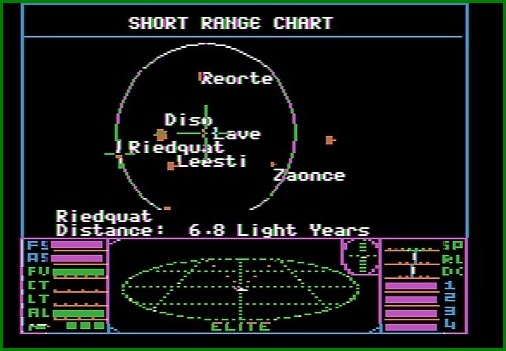For over a century, we are free to send into space are our most valuable assets For over a century, we are free to send into space are our most valuable assets as a gratuitous gift to extraterrestrial civilizations.

Buy low, sell high! How many millions of earthlings spoil yourself eyesight game Elite!
Sometimes all you want to rest, even Nobel laureate in economics Paul Krugman. A few years ago, he wrote an essay on the theme of the unexpected - the interstellar finance, as, of course, had long been forgotten, but it feels like once again to recall. Teleport copy of the article on automated reading device can be here.
The author gladly tell, though serious, satirical notes too visible. It says that, as is known, is a function of the inertial reference system and accelerating the system. According to the theory of relativity, the earth rose, which ordered a resident of Alpha Centauri, you can give him fresh, but the client by the time long ago died of old age.
In other words, the main problem of interstellar trade - huge distances. Norma will not shuttling back and forth freight ships, and flying one way. Naturally, electromagnetic communication much faster transportation of material goods (by the way, with such a situation we have encountered on Earth).
It also shows that the interstellar arbitration and competition is likely to equalize interest rates between the two locations (planets, ringed worlds, Dyson spheres, everything), are in the same inertial frame of reference. From the point of view of astrophysics it is quite competent remark. The average relative velocity of the stars in our part of the Milky Way is 10-40 km / s. By earthly standards, this is a lot, but the ratio of the relativistic time dilation between the systems in this case does not exceed 1.0000000089, that is one millionth of a cent.
In general, there is something to laugh and think, and Caleb Scharf, director of the multidisciplinary astrobiological Center at Columbia University (USA), seriously puzzled by the question of the fundamental necessity of interstellar trade. The more intelligent beings could share, despite the huge distances?
Mr. Scharf first thing dismisses stamps science fiction is hardly someone (or something?) Will want to take from planet to planet metal ores and other minerals, the water, the spheres of beryllium, dilithium crystals, helium-3, or any other raw materials. The bottom line is that they all are made up of elements lavishly produced by supernovae and stellar nucleosynthesis. Therefore, these materials are a) already have in your solar system - or b) they can easily get in one of the billions of uninhabited corners of the cosmos.
It is more likely that others will be the subject of trade goods that Mr. Scharf divides into two broad categories. First, biological products.
Billions of years of natural selection and evolution on any suitable to this planet will lead to the emergence of wonderful and useful forms of life, as well as biological structures such as sea shells, or honeycomb, the uniqueness of which cause them concern on the part of the inhabitants of other planets. The scientist is convinced that no matter what skill or reach certain intelligent beings in the field of genetic manipulation, hardly compares to our imagination with the result of the nature of games. Fluffy bunnies and butterflies surely enchant young aliens from the other side of the galaxy.
Secondly, it is something that can only create a reasonable creature that has the knowledge, creativity and technologies that can embody the idea into life. Now, of course, it's hard to imagine that in the future will be able to offer corporations such as Intel Interstellar or Google Galactic; maybe perfume with the scent of intelligence? Works of art will also be in demand: some aliens may strike Picasso, and others - Caravaggio.
But still the largest segment of the interstellar market, according to Mr. Scharf, take goods that do not need to carry. Ideas, software, mathematics, scientific theories, literature, music, pictures.
Provided, of course, that these ideas will not harm anyone. (Here the scientist Stephen Hawking says that a couple of years ago, reminded mankind of the dangers of contacts with extraterrestrial civilizations, saying that they are not leaving their home planet, to share with us by some shocking ideas that will lead us to ruin.
But wait! What do we do? For the past century, we have a completely free ship into space are our most valuable asset!
Radio shows, television series, all of our conversations through electromagnetic coupling funneling into interstellar space - at least flowed for several decades, until we began to switch to low-power digital transmission of data, and not muted tone.
Are we thus have spoiled their economic future? Yes unlikely. We just accidentally invented the freemium business model long before most of the term.
Billions of sentient beings are caught every word, every second rerun Happy Days and advertising a set of knives in the TV shop. We just have to figure out how to translate them into a more profitable tariff plan.
Fortunately, Paul Krugman has created a theory of interstellar finance, so we do not take work to develop an attractive pricing policy.
in the wake of Scientific American, compulenta.computerra.ru
Great Educational Speakers
Nobody wants to die. And not only that, people especially don't want to die poor. But if you have to die, and God forbid, die penniless, it's good to have lavished sufficient praise on a deity so you might be in his good favor in the afterlife.
According to the astrophysicist Neil deGrasse Tyson, these fears account for "the most expensive, ambitious projects humans have ever undertaken."
Take the Pyramids, which are "basically expensive tombstones," Tyson says. The praise of deity or royalty also got us the great cathedrals of Europe. We're not investing the same portion of our wealth and energy in churches nowadays, but Tyson says the other two fears are still quite powerful.
War, or the fear of death led to the construction of The Great Wall of China. It also led to the Manhattan Project and the Apollo Project. But would the threat of war get us to Mars today? It's conceivable, but not likely. So if "kings and gods are not sufficient in modern times to undergo heavy projects," Tyson asks, what's left?
The promise of economic return. That's what is responsible for hugely expensive enterprises such as the voyages of Columbus, Magellan voyages, and Lewis and Clark.
In the video below, Tyson wholeheartedly endorses this driver, as the impact would be as follows:
"You can go into space, transform society, change the zeitgeist of your culture, turn everyone into people who embrace and value science, technology, engineering and math, the STEM field."
Transcript -- So about a decade ago I realized that if we were going to go to Mars with people it would be really expensive, and so I thought to myself: what activities have human cultures engaged in, in the past that were as expensive as what it might be to go to Mars and what motivated them to spend that money? I was going to fill a whole book, "Motivations to do Great Things, Great Expensive Things," and then I'd find the task, I'd find the activity that most closely resembled what it would be to go to Mars in the 21st century and I'd say, oh, is that what that culture did with their population, is that how they raised the money, is that how they convinced the people? I was going to fill a whole book of this. It would be a nice little reference catalog about how to get something done in modern times.
In conducting that exercise what I found is that there are only three drivers, not more, not less, three drivers that account for the most expensive, ambitious projects humans have ever undertaken. One of them is the praise of deity or royalty. That's what got you the pyramids. They're basically expensive tombstones. That's what got the cathedral and church building of Europe. That was a period where huge fractions of societal investment went into those activities. There is less of that today, so that's not really a useful driver to think about how we might transform the 21st century. Another driver is war. Nobody wants to die. That gets you the Great Wall of China. That gets you the Manhattan Project where we built the bomb. That gets you the Apollo Project. Another driver, the search for economic return—nobody wants to die, nobody wants to die poor. The search for economic return, that's what is responsible for the Columbus voyages, the Magellan voyages, Lewis and Clark figuring out what is beyond that frontier in hugely expensive enterprises, conducted by governments.
So if we're going to go to Mars, and if war is not the driver—because it could easily become the driver if you get another space race with someone we view as a military adversary; I wonder who that might be—but if peaceful heads prevail, then war is not the driver available to you. Let's check our list. Well, kings and gods are not sufficient in modern times to undergo heavy projects such as that. What's left? The promise of economic return.
You can go into space, transform society, change the zeitgeist of your culture, turn everyone into people who embrace and value science, technology, engineering and math, the STEM field. Whether or not people go into space or serve the space industry they will have the sensitivity to those fields necessary to stimulate unending innovation in the technological fields, and it's that innovation in the 21st century that will drive tomorrow's economies.
Any frontier in space now involves biologists—we're looking for life—, chemists, geologists, physicists, mechanical engineering, electrical engineers, aerospace engineers, astrophysicists, all the traditional sciences and engineering frontiers are captured in any ambitious goal to explore space. We can recapture those times and reinvent America. We've already invented America once before. It's ripe. It's ready and it's willing, I think, to be invented again.
Directed / Produced by Jonathan Fowler & Elizabeth Rodd
 Scientists have proven means of computer Godel's theorem, which implies the existence of a supreme being.
Scientists have proven means of computer Godel's theorem, which implies the existence of a supreme being.